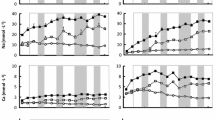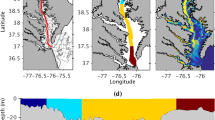Abstract
This contribution presents a new perspective on water chemistry and its relation to tidal hydrology in marsh-dominated estuaries. Results are derived from both field and modeling experiments. A heuristic model based on a tidally-averaged advection-dispersion equation is used in conjunction with source-sink terms (for benthic, marsh surface, and open-water exchanges) to make predictions of nutrient concentrations in the water column. Spring-neap tidal contrasts are associated with significant changes in water-column chemistry for a variety of nutrients sampled during the growing season in the Parker River estuary (Massachusetts). For ammonium, phosphate, nitrate plus nitrite, total dissolved N, and total dissolved P, concentrations are significantly lower during spring tides (marshes flooded) than during neap tides (marshes unflooded). Model results indicate that physical changes and open-water processing are insufficient to produce the observed effect, and that explicit biogeochemical processing on marsh surfaces is required. Field observations of changes in nutrient to nutrient ratios with the onset of marsh inundation also support this conclusion. As tides progress from the neap to spring condition, a “spectrum” of trajectories emerges in salinity-nutrient plots developed from both observational datasets and model output. Care must therefore be exercised in designing sampling programs for water chemistry in marsh-dominated ecosystems and in interpreting the resulting mixing diagrams.
Similar content being viewed by others
Literature Cited
Boon, J. D. 1978. Suspended solids transport in a salt marsh creek—An analysis of errors, p. 147–159.In B. Kjerfve (ed.), Estuarine Transport Processes. University of South Carolina Press, Columbia, South Carolina.
Bowden, W. B., C. J. Vörösmarty, J. T. Morris, B. J. Peterson, J. E. Hobbie, P. A. Steudler, andB. Moore. 1991. Transport and processing of nitrogen in a tidal freshwater wetland.Water Resources Research 27:389–408.
Chalmers, A. G. andR. G. Wiegert 1985. Nutrient flux in Georgia marshes as measured in flumes.Estuaries 8:74A (Abstract).
Chambers, R. M., J. W. Harvey, andW. E. Odum. 1992. Ammonium and phosphate dynamics in a Virginia salt marsh.Estuaries 15:349–359.
Childers, D. L., andH. N. McKeller. 1985. Nutrient variability and subsystem interactions in a southeastern salt-marsh.Estuaries 8:117A (Abstract).
Dyer, K. R. 1973. Estuaries: A Physical Introduction. John Wiley and Sons, New York.
Dzierzeski, M. J. 1991. Factors controlling the invasion ofLythrum salicaria (purple loosestrife) in a hydrologically altered salt marsh. M.S. Thesis, University of New Hampshire, Durham, New Hampshire.
Fry, B., M. Hullar, S. Saupe, B. J. Peterson, andR. T. Wright. 1992. DOC production in a salt marsh estuaryArchiv fur Hydrobiologie Beiheft 37:1–8.
Gardner, L. R. 1975. Runoff from an intertidal marsh during tidal exposure—recession curves and chemical characteristics.Limnology and Oceanography 30:81–89.
Glibert, P. M. andT. C. Loder. 1977. Automated analysis of nutrients in seawater: A manual of techniques. Woods Hole Oceanographic Institution, Woods Hole, Massachusetts. Technical Report No. 77-47.
Hall, C. A. S., N. Tempel, andB. J. Peterson. 1979. A benthic chamber for intensely metabolic lotic systems.Estuaries 2:178–183.
Harleman, D. R. F., A. T. Ippen, andJ. D. Lin. 1960. Turbulent diffusion and gravitational convection in an idealized estuary. Department of Civil and Sanitary Engineering, Massachusetts Institute of Technology, Cambridge, Massachusetts. Technical Report 38.
Harleman, D. R. F., D. W. McDougall, C. J. Galvin, andJ. A. Hoopes. 1961. An analysis of one-dimensional convective diffusion phenomena in an idealized estuary. Dept. of Civil and Sanitary Engineering, Massachusetts Institute of Technology, Cambridge, Massachusetts. Technical Report 42.
Hayes, M. O. 1970. Geomorphology and sedimentation of some New England estuaries, Chapter XII.In J. R. Schubel (ed.), The Estuarine Environment-Estuaries and Estuarine Sedimentation. American Geological Institute, Falls Church, Virginia.
Heinle, D. R. andD. A. Flemer. 1976. Flows of materials between poorly flooded tidal marshes and an estuary.Marine Biology 35:359–373.
Hydroscience. 1971. Simplified mathematical modeling of water quality. Report to the United States Environmental Protection Agency. Hydroscience, Inc., Westwood, New Jersey.
Ippen, A. T. andD. R. F. Harleman. 1961. One-dimensional analysis of salinity intrusion in estuaries. Committee on Tidal Hydraulics, United States Army Corps of Engineers, Vicksburg, Mississippi. Technical Bulletin 5.
Jordan, T. E. andD. L. Correll. 1985. Nutrient chemistry and hydrology of interstitial water in brackish tidal marshes of Chesapeake Bay.Estuarine, Coastal and Shelf Science 21:45–55.
Kjerfve, B. J., L. H. Stevenson, J. A. Proehl, T. H. Chrzanowski, andW. M. Kitchens. 1981. Estimation of material fluxes in an estuarine cross section: A critical analysis of spatial measurement density and errors.Limnology and Oceanography 26:325–335.
Lee, V. 1979. Net nitrogen flux between the emergent marsh and tidal waters. M.S. Thesis, University of Rhode Island, Kingston, Rhode Island.
Loder, T. C. and P. M. Glibert. 1977. Blank and salinity corrections for automated nutrient analysis of estuarine and sea waters, p. 48–56.In Advances in Automated Analysis, Technicon International Congress 1976, vol. 2.
Loder, T. C. andR. P. Reichard. 1981. The dynamics of conservative mixing in estuaries.Estuaries 4:64–69.
Mann, K. H. 1975. Relationship between morphometry and biological functioning in three coastal inlets of Nova Scotia, p. 634–644.In L. E. Cronin (ed.) Estuarine Research, vol. 1. Academic Press, New York.
Nixon, S. 1980. Between coastal marshes and coastal waters—A review of twenty years of speculation and research on the role of salt marshes in estuarine productivity and water chemistry, p. 437–525.In P. Hamilton and K. B. MacDonald (ed.), Estuarine and Wetland Processes: With Emphasis on Modelling. Plenum Press, New York.
O'Connor, D. J. andJ. A. Mueller (eds.). 1980. Basic models of natural water systems: Applications to waste load allocations. 25th Summer Institute in Water Pollution Control, Environmental Engineering and Science Program, Manhattan College, Bronx, New York.
Odum, E. P. 1968. A research challenge: Evaluating the productivity of coastal and estuarine water. Proceedings of the Second Sea Grant Conference. University of Rhode Island, Kingston, Rhode Island.
Odum, E. P., J. T. Finn, andE. H. Franz. 1979. Perturbation theory and the subsidy stress gradient.BioScience 29:349–352.
Officer, C. B. 1977. Longitudinal circulation and mixing relations in estuaries, p. 13–21.In Studies in Geophysics: Estuaries, Geophysics, and the Environment. National Academy of Sciences, Washington, D.C.
Pyott, C. J. 1990. Investigations into the effects of waterlogging stress on the high marsh grassSpartina patens. M.S. Thesis, University of New Hampshire, Durham, New Hampshire.
Rice, J. R. 1983. Numerical Methods, Software, and Analysis. McGraw-Hill, Inc., New York.
Schmidt, E. 1981. Water quality impact of non-point source contaminants in small tidal rivers. Ph.D. Dissertation, University of New Hampshire, Durham, New Hampshire.
Scudlark, J. R. andT. M. Church. 1989. The sedimentary flux of nutrients at a Delaware salt marsh site: A geochemical perspective.Biogeochemistry 7:55–75.
Solórzano, L. andJ. H. Sharp. 1980. Determination of total dissolved nitrogen in natural waters.Limnology and Oceanography 25:751–754.
Spurrier, J. D. andB. Kjerfve. 1988. Estimating the net flux of nutrients between a salt marsh and a tidal creek.Estuaries 11:10–14.
Stevenson, J. C., D. R. Heinle, D. A. Flemer, R. J. Small, R. A. Rowland, andJ. F. Ustach. 1976. Nutrient exchanges between brackish water marshes and the estuary, p. 219–240.In M. Wiley (ed.) Estuarine Processes, vol. II. Academic Press, New York.
Valiela, I., J. M. Teal, S. Volkmann, D. Shafer, andE. J. Carpenter. 1978. Nutrient and particulate fluxes in a salt marsh ecosystem: Tidal exchanges and inputs by precipitation and groundwater.Limnology and Oceanography 23:798–812.
Vörösmarty, C. J., B. Moore, W. B. Bowden, J. E. Hobbie, B. J. Peterson, andJ. Morris. 1983. The transport and processing of nitrogen in a tidal, freshwater marsh and river ecosystem: Modeling the roles of water movement and biotic activity in determining water quality, p. 689–698.In W. K. Lauenroth, G. V. Skogerboe, and M. Flug (eds.) Developments in Environmental Modeling 5: Analysis of Ecological Systems: State-of-the-art in Ecological Modelling. Elsevier, New York.
Waterman, E. R. P. 1991. A comparison of nutrient fluxes in three New England salt marsh systems. M.S. Thesis, University of New Hampshire. Durham, New Hampshire.
Welsh, B. L. 1980. Comparative nutrient dynamics of a marsh-mudflat ecosystem.Estuarine, Coastal and Shelf Science 10:143–164.
Welsh, B. L., R. B. Whitlatch, andW. F. Bohlen. 1982. Relationship between physical characteristics and organic carbon sources as a basis for comparing estuaries in southern New England, p. 53–67.In V. S. Kennedy (ed.), Estuarine Comparisons. Academic Press, New York.
Whiting, G. J., H. N. McKellar, J. D. Spurrier, andT. G. Wolaver. 1989. Nitrogen exchange between a portion of vegetated salt marsh and the adjoining creek.Limnology and Oceanography 34:463–474.
Wolaver, T. G. andJ. D. Spurrier. 1988. The exchange of phosphorus between a euhaline vegetated marsh and the adjacent tidal creek.Estuarine, Coastal and Shelf Science 26:203–214.
Wolaver, T. G., R. L. Wetzel, J. C. Zieman, andK. L. Webb. 1980. Nutrient interactions between salt marsh, mudflats, and estuarine water, p. 123–133.In V. S. Kennedy (ed.), Estuarine Perspectives. Academic Press, New York.
Wolaver, T. G., J. C. Zieman, R. Wetzel, andK. L. Webb. 1983. Tidal exchange on nitrogen and phosphorus between a mesohaline vegetated marsh and the surrounding estuary in the lower Chesapeake Bay.Estuarine, Coastal and Shelf Science 16: 321–332.
Woodwell, G. M., D. E. Whitney, C. A. S. Hall, andR. A. Houghton. 1977. The Flax Pond ecosystem study: Exchanges of carbon and water between a salt marsh and Long Island Sound.Limnology and Oceanography 22:833–838.
Wright, R. T., R. B. Coffin, andM. E. Lebo. 1987. Dynamics of planktonic bacteria and heterotrophic microflagellates in the Parker Estuary, northern Massachusetts.Continental Shelf Research 7:1383–1397.
Yelverton, G. F. andC. T. Hackney. 1986. Flux of dissolved organic carbon and pore water through the substrate of aSpartina alterniflora marsh in North Carolina.Estuarine, Coastal and Shelf Science 22:255–267.
Author information
Authors and Affiliations
Rights and permissions
About this article
Cite this article
Vörösmarty, C.J., Loder, T.C. Spring-neap tidal contrasts and nutrient dynamics in a marsh-dominated estuary. Estuaries 17, 537–551 (1994). https://doi.org/10.2307/1352402
Received:
Accepted:
Issue Date:
DOI: https://doi.org/10.2307/1352402




